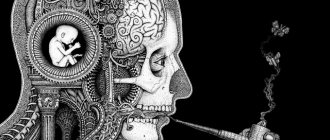What is psychoanalysis?
First, psychoanalysis is a method of treatment, and nowadays almost all psychoanalysts are doctors.
The psychoanalyst tries to relieve the patient's symptoms, freeing him from unnecessary doubts, unjustified feelings of guilt, painful self-accusations, false judgments and unreasonable impulses. In addition, he sets himself the goal of not only calming the patient, but also unraveling his personality. But the analyst is only a leader and observer, and the patient is ultimately responsible for the outcome of the entire process. Secondly, it is a method of scientific observation and study of personality, and in particular desires, impulses, motives, dreams, fantasies, early development and emotional disorders.
Third, it is a system of scientific psychology, that is, the observations and ideas of psychoanalysis can be used in trying to predict human behavior and the outcome of human relationships, such as marriage and parent-child relationships.
How is psychoanalysis performed?
The process of psychoanalysis consists of the study and reorganization of personality; This is done so that the individual can store his tensions with less difficulty until the time comes to release them. It is necessary to make the subconscious conscious and bring unsatisfied tensions under observation. It is believed that in order to be fully carried out, this process must last at least a year and consist of three to six sessions per week, each lasting about an hour. If the study lasts less than a year or the number of sessions is less than three per week, it is almost impossible to conduct the process effectively.
To conduct a psychoanalytic session, the patient lies on the couch, and the analyst sits in his head so as to be out of sight. Thanks to this, the patient’s psyche can work without distraction. In turn, this method relieves the doctor of unnecessary stress: without being under continuous observation, he can better concentrate on what the patient is saying.
The so-called free association method is used. This means that the free expression of the free flow of ideas is not restrained or changed by the usual censorship of consciousness (ideas of politeness, shame, self-respect).
In a state of free association, the patient's psyche is often filled with desires, feelings, reproaches, memories, fantasies, judgments and new points of view, and all this appears at first glance in complete disorder. However, despite the apparent confusion and incoherence, every utterance and every gesture has its own meaning in connection with one or another unsatisfied tension. Hour after hour, day after day, meanings and connections begin to emerge from the chaotic web of thoughts. Over a long period, certain central themes may gradually develop, relating to a number of tensions unsatisfied from early childhood, long buried in the subconscious and inaccessible to conscious recognition, which form the basis of the patient’s personality structure, the source of all his symptoms and associations.
9 pages, 4343 words
Methods for studying the psyche of children with intellectual disabilities.
... violations. Methods for studying the psyche of children with intellectual disabilities. Methods of psychological examination consist of methods of collecting information and methods of processing it. Collection...reflecting the possibilities of mastering the school curriculum, as well as the personality characteristics of the child. Analysis of psychopathological manifestations makes it possible to identify additional psychopathological...
The analyst's position in relation to the patient should be strictly neutral. The analyst's main job is, in a sense, to point out to the patient when he is deceiving himself; therefore, the doctor must always maintain a self-critical position, excluding any manifestations of sympathy and indignation towards the patient, which would give him the opportunity to deceive the doctor and himself. The analyst's unwanted emotional attitude toward the patient is called countertransference.
The question often arises: can psychoanalysis harm anyone? The greatest danger is to treat a patient on the verge of psychosis if the analyst is not aware of his true condition. The analyst must also be careful in distinguishing neuroses from certain brain diseases and hormonal disorders.
Based on materials from the book by E. Bern
4. What is hysteria from a psychoanalytic point of view? Her role in the discovery of psychoanalysis by Freud.
5. What are the methods of psychoanalysis? How do you understand talkingcure?
6. Expand the content of the concepts used by Freud: consciousness, unconscious, symptom, resistance, repression, sublimation. Show their relationship.
Psychology as a subject at university
In 2022, I decided to try to study psychology in more detail and found the Canadian course “Introduction to Psychology” on the courser.
A very good and high-quality course, voluminous and at the same time interesting. I was wondering how psychology could be a “subject” at university. I completed the course in about a month and a half, and learned a lot, from clinical and cognitive psychology, to an introduction to neuroscience and the principles of memory. A very clear and precise picture of what psychology is was formed in my mind. I highly recommend this course because... he dots his i’s perfectly. As for psychoanalysis, it is only in the “History” chapter. Steve Jordan (lecturer) first introduces fundamental concepts of psychoanalysis that seem quite funny, like the anal-retaining and anally-pushing personality types or the Oedipus complex. Then Steve said a set of words that I will remember for the rest of my life:
As for the effectiveness of psychoanalysis, ANY therapy will be more effective than no therapy. Especially for patients with big wallets.
It turns out that there is no point in paying 3,000 rubles per hour for a “specialist” psychoanalyst.
You can just as effectively hire a supportive psychologist for less money, and you can also find people on Avito who are ready to communicate with you and support you in difficult times for a fairly modest amount. This is if you have no friends. The lecturer also noted that the basic concepts of psychoanalysis were taken by Freud out of thin air and by their nature we cannot experimentally test or prove them. It is very reminiscent of religion, when a certain set of postulates is given without proof and to be accepted on faith.
Symptom - Basic concepts of psychoanalysis.
In a narrow sense, a symptom is a manifestation of a disease expressed in the patient’s complaints. In psychoanalysis we are usually talking about mental, psychogenic symptoms. 3. Freud paid considerable attention to the consideration of the nature of mental symptoms and the mechanisms of their formation and saw the main harm of symptoms in the mental costs that occur in a mentally ill person and which subsequently have to be carried out to overcome them. From his point of view, symptoms are a derivative of unconscious processes in which a person’s suppressed, repressed sexual drives and desires play a significant role.
In various works of Freud, different ways of formation of neurotic symptoms are considered - they can represent a specific expression of perverse drives, manifested in imaginary intentions and actions; be sediments of affective experiences, those mental traumas that patients experienced in childhood; it is a kind of compromise between uncoordinated mental processes - it repeats the type of infantile satisfaction, but distorted and causing a feeling of suffering. Fantasy plays an important role in the process of symptom formation. Despite the general picture, the formation of symptoms depends on the nature of the mental illness. The specific mechanisms of symptom formation are different in hysteria, obsessive-compulsive neurosis and other mental illnesses.
13 pages, 6368 words
Human personality in the computerized world
... became related to them. And although the computer needs a person, the person is now directly “connected” with the computer. Computer and... people who themselves have not encountered this problem only by hearsay (from films, books and the same articles), seem to describe “personality... separately. Hackers or hackers? The fbi.gov website was immediately hacked: Super cool hacker sent them an infection. It's a pity he didn't create a floppy disk...
In analytical therapy, the work involves two stages. In the first stage, libido is pushed away from symptoms and finds expression in the transference, concentrating on the analyst. In the second, the analyst’s efforts are concentrated on a new symptom (transference neurosis) with the goal of freeing the libido from it.
7. What is the personality structure according to Freud (two models).
The third model of the psyche (J. Lacan)
On the origin of neuroses and depression
Upbringing
represents a series of inevitable traumas for the child.
At the same time, the child is traumatized by the most significant people for him, whom he loves and who are authorities for him - these are parents, educators, teachers. To save his love for them and their authority, the child forgets about his traumas (see repression
).
And these difficult feelings associated with these traumas continue to exist in our unconscious, gradually poisoning our lives (see Survive in order to forget
).
Just as a leg broken in childhood can then hurt throughout life and cause lameness, childhood injuries also cause a series of chronic failures in life, neurosis and depression, but the cause of mental pain has already been forgotten.
S. Freud's personality theory
Freud took a radical approach to the study of people. Instead of placing consciousness at the center of a person’s mental life, he compared it to an iceberg, an insignificant part of which protrudes above the surface of the water, the rest, most of the iceberg, is unconscious.
Freud associates the structure of personality with the presented model of the psyche. Personality structure includes three components:
- super-ego (super-I);
- ego (I);
- id (it).
The “superego” is the conscious part and is a system of values, norms and ethics acquired in the process of socialization of the individual. In a narrow sense, we can say that the “superego” is the morality and conscience of a person. Appears at the age of 3-5 years. The “superego” conflicts with the “id” component.
“Ego” is an intermediary between the “superego” and the “id”. The ego seeks to express and satisfy the desires coming from the id in accordance with the norms and demands of the superego. In this way, the ego resolves the conflict between these structures and introduces rationality into human behavior. In this case, the “Ego” is guided by the principle of reality, the purpose of which is to preserve the integrity of the organism by delaying the gratification of instincts until the appropriate moment acceptable to the “super-ego”. The principle of reality allows the individual to slow down, gradually release the energy of the “id” within the framework of social restrictions and the human conscience, releases the energy of unconscious instincts indirectly, distorting them beyond recognition for consciousness.
The ego includes mental defense mechanisms that help a person escape from anxiety and pain.
The “id” is the entirely unconscious part of the personality and represents the instinctual and innate aspects of the personality. These biologically based drives (derived from biological needs) energize our behavior. The “id” energy seeks release based on the principle of pleasure, striving to discharge immediately. Thus, human motivation is entirely based on the energy (instincts) produced by bodily needs.
8. Why are dreams so important for psychoanalysis? What is the work of dreams (distortion, condensation and displacement), what is the relationship between the hidden and manifest content of dreams?
9. Analytical psychology of K. G. Jung. Psychotypes and basic mental functions according to K. G. Jung.
Psychoanalytic direction
The psychoanalytic direction is one of the most widespread and versatile concepts that go back to psychoanalysis. Today this direction is usually used in several meanings.
- The first is a theory, the founder of which is S. Freud.
- The second is a method of treating mental personality disorders.
- The third is a method used to determine the unconscious motives that determine a person's behavior.
S. Freud's ideas dominated almost the entire first half of the twentieth century, but they were supplemented by many researchers, starting with his closest student C. G. Jung.
- His daughter A. Freud also worked in this direction, but mainly with children aged 7 to 9 years and was able to create a theory of the metapsychological profile of a child, which is used by many psychotherapists to this day.
- M. Klein laid the foundation for psychosomatics by first talking about the fact that people often react with their bodies to all sorts of external circumstances and stimuli. She also drew attention to the fact that people can punish themselves for any actions.
- D. Winnicott was the first to point out that you can be lonely in the presence of another person, and he also became the founder of associative cards.
- E. Erikson developed a theory of human identity.
- S. Ferenczi devoted many works revealing the psychological study of traumatic events and stress.
- J. Lacan gave his point of view on a person’s relationships with other people and studied the factor of anxiety in detail. Many psychologists and even esotericists relied on his works.
Since the second half of the twentieth century, many scientists have questioned the psychoanalytic movement, since the methods used in it were mainly limited to observation. With the development of medicine and psychiatry, drug treatment has become increasingly used to treat mental disorders. And starting from the 80s of the last century, the basic concepts of psychoanalysis began to be considered obsolete, and S. Freud faded into history.
Quote At the heart of all our actions are two motives: the desire to become great and sexual attraction.
Sigmund Freud
C. G. Jung's theory of personality
Jung devoted his life to the study of unconscious drives. However, unlike Freud, Jung argued that the contents of the unconscious are more than repressed sexual or aggressive urges. According to Jungian analytical psychology, individuals are motivated by intrapsychic forces and images whose origins go back to the origins of evolution. This innate unconscious contains deep-rooted spiritual material that explains the inherent desire for creative expression in all humanity.
3 pages, 1090 words
The concept of human personality in psychology
... from 7 to old age) The concept of human personality in psychology The following aspects are important for psychological analysis: ... habits). 4. personality orientation – the highest level, hierarchically connected series. 1) desire, attraction, inclination 2) ideals 3) individual ... discharge in the external environment. The ego is the executive organ of the personality. 3. Super ego (super ego) – represents the internalized version of ...
Jung proposed his concept of personality. He argued that personality consists of three interacting structures: the ego, the personal unconscious and the collective unconscious.
— the ego is the basis of our self-awareness.
— the personal unconscious contains personal information that has already been suppressed or forgotten. Here are emotionally charged thoughts, feelings and memories drawn from personal and ancestral (hereditary) experience.
— the collective unconscious is the repository of human memory. Jung said: “The collective unconscious contains the entire spiritual heritage of human evolution, reborn in the structure of the brain of each individual.”
10. Basic mental processes. Sensation and perception.
How to study CBT
My area of expertise in CBT is built around depression and one great book by David Bjorn, Mood Therapy.
A clinically proven way to beat depression without pills . In 2022, it was properly translated into Russian, so I highly recommend its in-depth study. This is if you have mood problems. CBT has been used successfully for many other problems and ideally you should look for a self-help book that specializes in your problem. Or a specialist. Of course, in case of serious problems, you should contact a specialist.
The topic of artificial intelligence is very popular on Habré, and the reader may have a question: does a psychotherapist bot exist? Of course, there are working prototypes, but they are of extremely low quality. At best, they only measure the Beck Index and provide a three-column technique (ABC model), and everything else is educational videos on meditation practices that can complement, but not replace, CBT. I communicated with WoeBot and Wysa for a week and was not satisfied. It seems that they give, at best, 20% of David's book, although they could do cool customization by chapter and a lot more CPT exercises and various tests-measurements-graphs, instead of shitty videos.
If you have interesting and exciting stories from personal experience that touch on the topic of CBT or Psychoanalysis, you can send them to
Crowd Psychology
The founders of social psychology, Gabriel Tarde, author of the book “The Laws of Imitation” (1890) and Gustav Le Bon “Psychology of the Masses” (1895), gave a clear description of the psychology of the crowd and man as part of the crowd, the mass.
What changes, in their opinion, happen to a person when he is among a mass of people?
The inclusion of the individual in the mass leads to depersonalization, to the fact that the individual becomes averaged and loses his personal qualities. He seems to degrade while in a crowd, his criticality decreases, personal responsibility and fear disappear, confidence and a feeling of increased power appear, so in a crowd a person does not assess the magnitude of the real danger. People's suggestibility increases. In a crowd, feelings dominate over reason. The crowd is impulsive and aggressive. In a crowd, emotions and actions are highly contagious - they are quickly transmitted from one person to another.
The crowd is a primitive herd that needs a strong, powerful and authoritative leader. She will obey the one who calls herself her leader and declares respect and love for those gathered. You need to be able to talk to a crowd: speech should be emotional and simple, not lose eye contact with people, promise and say what the crowd wants to hear, because it craves illusions. The crowd needs the love of the leader and can make any sacrifice if he calls.
2 pages, 941 words
Qualities and personality traits of a leader
... leaders and values on the scales of R. Cattell’s test, characterizing respondents as leaders. Currently, the most sought-after quality of a leader’s personality is leadership potential. ... the potential of a leader showed that with obvious attention to the problem of the activity of a leader, many questions regarding the concept and structure of the leadership potential of a leader as a subject...
It is unsafe to be in a crowd, because while being in a crowd people’s psyche changes.
Is psychology a science or not?
And it depends on what language you are using.
The Russian word “psychology” carries a negative connotation and is usually associated with manipulation and deception, as well as trash books “about nothing.” And in the West, psychology is a full-fledged science based on mathematics (statistics), using an experimental approach and two dominant schools (behavioral and cognitive). Back in school, I began to think deeply about what was wrong with psychology. I had depression with a seasonal pattern, and I hoped to master psychology on my own and figure everything out on my own. I reflected a lot on my thoughts and noticed that if you think differently, you can successfully regulate your mood. You can also measure mood in numerical form (on a scale from 0 to 10), take measurements BEFORE and AFTER some activity, and then mathematically process these results and, based on average values, draw conclusions about the effectiveness of approaches. I invented something like primitive CBT, where every morning I go through a special piece of paper with questions, remember negative thoughts and reformulate them into positive ones. This was in 2013 and I remember how my quality of life increased. My goal is to someday learn English and find an area of psychology that has thought exercises.
The concept of “leadership” and “management” in a group
Social management of a group must be carried out through various phenomena of interpersonal influence (leadership and management).
Let us give a description of each of them.
Group leadership is a process of interpersonal influence. A leader is generated not so much by personal qualities or their special combination, but by the structure of relationships in a given specific group. This system of interpersonal connections is formed and determined by the goals of the group, the values and norms that have formed within it. And it is on the basis of these values and goals that a specific group leader is nominated. The leader, as it were, personifies the system of goals and values preferred by the group, is their bearer, an active guide to life. He is recognized as having the right to lead and be the final authority in assessing various group situations and circumstances.
In practice, the leader is often determined through a system of sociometric elections as the most emotionally preferred member of the group. This is not always a justified approach. In social psychology it is known that a sociometric star is not always a leader. Thus, the “star” can be characterized as the “soul of the group,” the center of its emotional attraction. This is a person to whom people are drawn in communication and feel comfortable around him. A leader is a person vested with power, having authority and the right to influence and evaluation.
It is interesting that, due to his focus on a certain sphere of the group’s life, one or another leader is always in opposition either to the communication-oriented members of the group, or to the tasks and goals of the group. A leader focused on the effectiveness of achieving a group goal is forced to worsen relationships with group members who do not fully or partially accept group goals.
In any real group, several diverse leaders can simultaneously exist, occupying their own “ecological” niches in it and without entering into serious contradictions with each other. This is all the more possible since within each of the two identified areas there may be an even deeper differentiation of leadership roles. Thus, within instrumental leadership one can identify a leader-organizer, a leader-initiator, a leader-erudite, a leader-master, a leader-skeptic, etc. And among expressive leaders there are: leader of emotional tension (sociometric “star”), leader-generator of emotional infusion, etc.
In general, the higher the level of development of a group, the more different manifestations of the process of leadership influence there may be.
Management–
another form of implementing social management in a small group. Leadership can be defined as the process of managing a group, carried out by a leader as an intermediary of social control and power on the basis of legal authority and norms of the larger social community in which the small group is included.
21 pages, 10162 words
Guidelines for organizing the activities of psychological, medical and pedagogical...
... the education system of the Russian Federation" and the draft regulations on PMPK, presented to the leaders of PMPK at the All-Russian seminar-meeting in St. Petersburg, held on 18-19 ... activities by education management bodies and educational institutions"; · this Guide is also intended to help in organizing the activities of PMPC. Target …
That is, on the one hand, management and leadership solve similar problems of the same order: stimulating groups, targeting them to perform certain tasks, finding means to effectively solve them. On the other side. Leadership is a psychological characteristic of the behavior of certain group members, and leadership is a social characteristic of relations in a group, primarily from the point of view of the distribution of management and subordination roles.
In the leadership of a small group there are always two layers, two aspects - the formal legal aspect of power, which can be called “administration”, and the psychological aspect of power, which in many ways brings the leader closer to the informal leader in terms of ways of influencing group members. However, despite the fact that in their psychological essence the phenomena of management and leadership are quite close, most often the leader and the group leader have different orientations: the leader is entirely focused on the task, and the leader is more focused on the internal interests of the group. In this case, if the expressive leader becomes a formal leader, he either ruins group activities or is forced to reorient himself to instrumental functions, coming into conflict with the group. That is, he either does not become a leader or ceases to be a leader.
Thus, the main instrument of the leader’s psychological influence on the group is his authority. The question arises: what determines the magnitude and degree of authority of a leader? Let us highlight a number of psychological factors. These include some personal characteristics, organizational and motivational potential (the ability to lead as a leader-organizer and a leader-motivator), the value attractiveness of the leader’s personality for group members and, the most significant factor, the management style implemented by the leader. Let's dwell on this last factor.
It is customary to distinguish three main models of leadership, which differ in the most important components of the group management style on the part of the leader - authoritarian, democratic, permissive.
The advantages of the authoritarian model are its structural simplicity and possibilities for operational use, as well as the fact that it closes and protects the leader psychologically. Significant disadvantages of this model are the passivity of subordinates, their hypocrisy in relation to the goals of the activity and the leader. In addition, the authoritarian model is internally conflicting, as it relies on pressure and dictate, which from time to time will explode the group from within through violent, difficult-to-resolve conflicts.
The undoubted advantages of the democratic model are its progressiveness, economy and humanity, which are expressed in the ability to solve complex group problems with a small number of highly qualified subordinates, good mutual understanding between the leader and subordinates, low conflict levels of the group and the manageability of its conflicts, free development of the group as a whole and its individual members. It is difficult to talk about the shortcomings of such a model; it is more logical to note that in its implementation it faces a number of difficulties.
Examples of similar educational works
Classification of groups of people
... The main parameters with the help of which a socio-psychological analysis of a group is possible are the characteristics of the group itself and the characteristics that determine a person’s position in the group. To the characteristics of the group... perception of its leaders and authorities...
Basic mental functions of a mentally retarded child
... the whole spectrum of mental disorders can be observed. Considered as a synonym... 1. - Vygotsky L.S. The main problems of modern defectology. – M.: ... but it’s possible in any social group. Speech develops with a delay, but...
Peculiarities of mental development of an adult’s personality
... in the human mental sphere. The adult was considered to be in a state of “mental fossilization.” “Human adulthood is equivalent to ... the psychophysiological functions, intelligence and personality of an adult. A new stage in scientific...
Development of a young person’s personality through intellectual and creative games
... people who are far from practice are trying to implement phenomena ... DEVELOPMENT AND CORRECTION OF PERSONALITY OF ADOLESCENTS AND YOUTH. ... formulating concepts, performing basic mental operations (classifications, ... existing in the teenager’s reference group. Finally, one more thing ...
TEACHER'S PERSONALITY. MODERN REQUIREMENTS FOR IT AND ITS MAIN QUALITIES
... in the spiritual world of man his social, moral, psychological and aesthetic qualities.” “A person rises to the level of personality only ... through education, as well as through diagnosing and correcting the mental development of schoolchildren. 4. Mandatory innovative...
In my social circle
Actually, I started asking my friends what they thought about psychology in general. It turned out that among all my friends there is not a single supporter of CBT (!!!). I managed to convert 2 out of 4 acquaintances to CBT and now I have them, but at the time it seemed kind of crazy. I began to feel like a cultist of CBT, which works wonderfully in practice and allows me to improve my quality of life. I regularly took the Beck Depression Test and saw that mood can be measured numerically. I started practicing the exercises from David Bjorn's book Mood Therapy.
A clinically proven way to beat depression without pills . At that time, it had not yet been properly translated into Russian, and I read it in English, and did the exercises in English too, and it worked out great. I also developed an Android application to do these exercises on your smartphone and track them. I had 3 powerful CBT series for several months (end of 2022, beginning of 2022 and end of 2019). By the end of 2022, I managed to learn to live even better than my healthy friends. I measured their Depression Index and mine, which dropped to zero for a short period of time. True, if you don’t do them, then he usually returns to the level of mild depression, but still these exercises leave a powerful imprint on the mind and in some aspects “switch” the functioning of the brain.
The first cool advantage of CBT follows from this - you can practice it completely independently, and the entry threshold is not very high (although it was not familiar at first). With CBT, you quantify your mood (BDI test), and you can even graph it and watch your depression score drop. Research shows that CBT training can reduce moderate to mild depression in just a couple of months for the average patient (see graph at the very beginning of the book). This is exactly the schedule I got, and maybe even more favorable.
In the case of psychoanalysis, no average guarantees are given to you, and no measurements will be taken, indicators will not be tracked. A cunning psychoanalyst will tell you that you need to go for at least a year to achieve at least some results, and they will not be guaranteed even with such a duration. This is very convenient and profitable for a psychoanalyst, because you can siphon money from a patient for months for “analysis”, while the result of the work cannot be monitored or verified in any way. This creates ideal conditions for scammers. Analogues can be drawn with some state projects of strict secrecy, which are hidden precisely because there is nothing to show there except for cutting.
In 2022, one friend (whom I subsequently turned to CBT) also had problems with her mood and actively recommended to me a psychoanalyst who was “good”, “nice”, “experienced” and “empathic”, and also charged 4,000 rubles per hour for an appointment . Even then I knew about CBT, but I decided to go to an appointment. At the appointment, I described my problems and said that I had heard about the scientific approach and measurements, about the dominance of CBT in Western medicine. I told him that I wanted him to analyze me according to the canons of psychoanalysis (or psychodynamics), and that I would test all the concepts and ideas that he puts forward by reading literature in English. And then he started to back up. This was my first and last psychoanalytic session.










